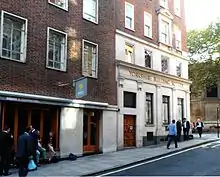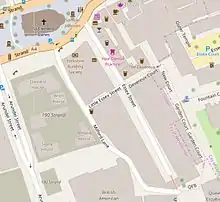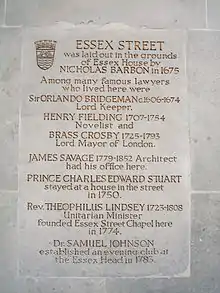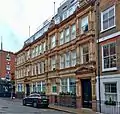Essex Street, London
Essex Street is a street in the City of Westminster that runs from Milford Lane in the south to Strand in the north. It is joined by Little Essex Street on its western side and Devereux Court on the eastern side. It was laid out by Nicholas Barbon in around 1675 or 1680 and contains a number of listed buildings.


History
Essex Street was laid out by Nicholas Barbon[1] between 1675 and 1680, on the grounds of the former Essex House which itself stood on the site of the Outer Temple, once owned by the Knights Templar. The highwayman Tom Cox, who was hanged at Tyburn in 1691, was captured in the nearby St Clement Danes churchyard after one of his victims spotted him coming out of his lodgings in Essex Street.[2]
In the first half of the twentieth century, the street was known for its publisher's offices such as Chapman & Hall,[1] and Methuen & Co. (No. 36).[3] Macmillan were at 4 Little Essex Street until 1990.[1] The Roman Catholic journal Merry England, edited by Wilfrid Meynell, was published from 43 Essex Street.[3]
Buildings
Essex Hall, an office building at numbers 1 to 6, is the headquarters of the British Unitarians.[4] Prior to the Blitz, a chapel and meeting rooms were on the site, continuing the association with the first avowedly Unitarian place of worship in London, dating back to 1774,[1] when Theophilus Lindsey founded the Essex Street Chapel.[5]
23 Essex Street houses a firm of legal barristers.[6]
The Edgar Wallace, a public house at No. 40, is on the site of the former Essex Head Tavern,[1] where Samuel Johnson and Richard Brocklesby founded the Essex Head Club in 1783.[7]
There are a number of listed buildings in the street. Numbers 11, 14, 19, 34 and 35 are all grade II listed. No. 32 is grade II* listed; California House is grade II listed; and the triumphal gateway at the southern end of the street (c.1676), which once screened it from Essex Wharf and its neighbouring wharfs beyond, is grade II listed. The gateway was damaged by bombing during the Second World War, and after repairs it was incorporated into a 1953 office building that now encloses the southern end of the street, apart from pedestrian access by steps to the southern part of Milford Lane.[8]
Little Essex Street
The Cheshire Cheese, a public house at 5 Little Essex Street, stands on a site where there has been a tavern since the 16th century.[1] It is a Grade II listed building, which was rebuilt in 1928 by the architect Nowell Parr, on the site of an earlier pub, for the 'Style & Winch' Brewery.[9]
Notable former residents
- Henry Fielding, novelist and author of Tom Jones.[1]
- Brass Crosby, radical lawyer, member of Parliament and Lord Mayor of London.
- James Savage, architect, had his offices in the street.[1]
- Sir Orlando Bridgeman, Lord Keeper.
Gallery
 Map by Wenceslaus Hollar (c. 1677) showing Essex House and grounds before Essex Street was laid out
Map by Wenceslaus Hollar (c. 1677) showing Essex House and grounds before Essex Street was laid out London County Council plaque on Essex Hall at 7 Essex Street
London County Council plaque on Essex Hall at 7 Essex Street.jpg.webp) The Cheshire Cheese in Little Essex Street
The Cheshire Cheese in Little Essex Street Nr. 20 Essex Street doubled as Bertram's Hotel in the 1987 Miss Marple episode "At Bertram's Hotel"
Nr. 20 Essex Street doubled as Bertram's Hotel in the 1987 Miss Marple episode "At Bertram's Hotel" California House
California House Essex Street south end with the water gate at the end
Essex Street south end with the water gate at the end The Essex Street steps at the south end
The Essex Street steps at the south end
References
- "Essex Street" in Christopher Hibbert; Ben Weinreb; John Keay; Julia Keay (2010). The London Encyclopaedia. London: Pan Macmillan. p. 277. ISBN 978-0-230-73878-2.
- Smith, Captain Alexander (2002). Arthur L. Hayward (ed.). A Complete History of the Lives and Robberies of the Most Notorious Highwaymen, Footpads, Shoplifts and Cheats of Both Sexes: Previously Published 1719 and 1926 (Reprint ed.). Abingdon: Routledge. p. 56. ISBN 978-1-136-48416-2.
- Williams, George G. Assisted by Marian and Geoffrey Williams. (1973) Guide to literary London. London: Batsford. p. 87. ISBN 0713401419
- "Contact us". Unitarians.org.uk. Retrieved 18 February 2017.
- Walford, Edward. (1878) Old and New London: A narrative of its history, its people, and its places. London: Cassell Petter & Galpin. British History Online. Retrieved 14 December 2016.
- 23 Essex Street Chambers, accessed 16 December 2022
- James Sambrook, "Essex Head Club (act. 1783–1794)", Oxford Dictionary of National Biography, Oxford University Press, 2004-2016. Retrieved 17 November 2016. (subscription required)
- Historic England. "Essex Watergate Closing South End of Street (1066823)". National Heritage List for England. Retrieved 17 November 2016.
- Historic England. "Cheshire Cheese Public House (1431970)". National Heritage List for England. Retrieved 17 November 2016.
External links
 Media related to Essex Street, London EC2 at Wikimedia Commons
Media related to Essex Street, London EC2 at Wikimedia Commons The full text of A Letter from Thomas Lawrence, M. D. to William Heberden, M. D. and F. R. S. concerning the Effects of Lightning, in Essex-street, on the 18th of June, 1764 at Wikisource
The full text of A Letter from Thomas Lawrence, M. D. to William Heberden, M. D. and F. R. S. concerning the Effects of Lightning, in Essex-street, on the 18th of June, 1764 at Wikisource- The Diamond Maker by H G Wells